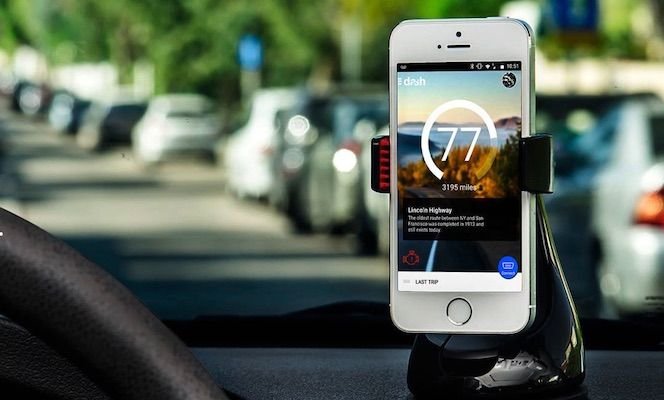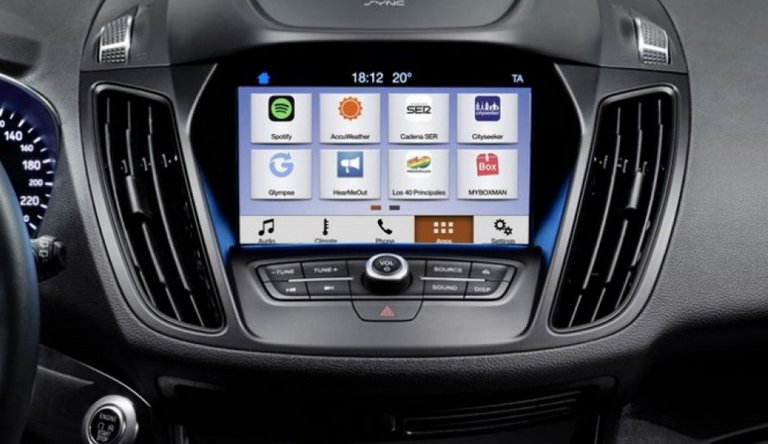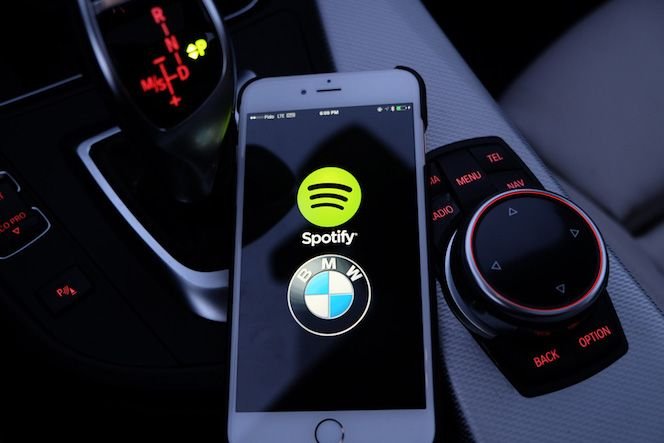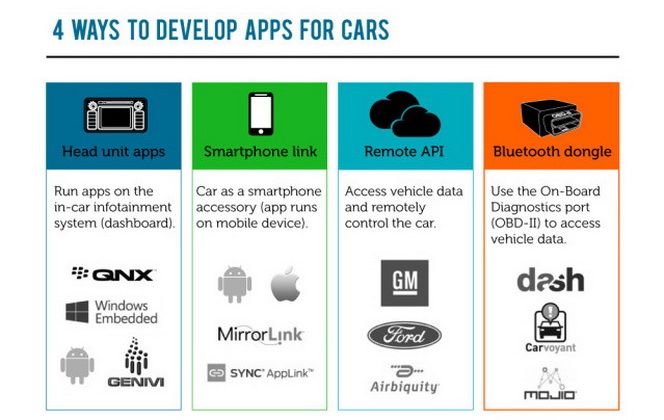For the most of us, our cars are a part of our daily life routine. We depend on them for work purposes, family needs, friends meetings, etc. The cars now allow us to access the Internet, make hands-free voice calls, navigate on autopilot mode, have the electronic maps directly in the dashboards, and so much more. But what is more important these days is that modern cars keep evolving due to the capacities of IoT and connected car apps development.

World-famous manufacturers like Nissan, AT&T, Volvo, General Motors, Renault and BMW gifted their clients with the best connected car apps that you can download right from the app stores. Such software allows users to personalize their cars, applying the latest technology achievements made by developers. Simply put, in term of functions the connected car apps are similar to the smartphone apps — they make driver’s life so much easier.
“Given the broad scope of interaction, the possibilities around the connected car seem limitless. To provide some context, PwC predicts that by 2022 the connected car space could grow to $155.9 billion, up from an estimated $52.5 billion in 2017. However, these revenues will become increasingly fragmented as a result of new services, technologies and suppliers.”
Source: PwC.com
And the coolest part is that the smart car’s market is expecting the new wave of IoT connected car apps that would be a focus for car makers of next generation. The concept has already become accepted by the mass market, so the app developers are totally prepared for the challenges of this new app development space. As for the entrepreneurs, they must be ready to capitalize on this technology trend. The experience of trailblazing brands that embraced the connected car apps development shows that the ROI index is perfectly satisfying for those businessmen who build software for connected cars.

So, let’s review the best approaches on how to build something like BMW or Volvo connected car apps. Each one of them has already been tested and implemented in real life. You may choose the most likable of them for you to penetrate this market boom.
Developing Connected Car Apps: 5 Best Approaches

#1. In-Vehicle Infotainment (IVI) Systems Apps
Such IVI systems typically provide drivers and passengers with entertainment and information delivery. In order to ensure this services, in-vehicle infotainment systems apps are allowed to use audio/video interfaces (A/V), two-way communications, vehicle voice commands, touchscreens, keypads, hands-free phone feature, etc. Most of the infotainment systems also provide security measures to prohibit drivers from using video features and other distracting services.
Thanks to these apps our cars process digital vehicle diagnostics, traffic information, cell phone calls and texts, emails, even warning and emergency help features. The app developers face the challenge of building connected car apps in a manner when a driver can receive the information without its interference with the actual driving. So, developing these apps isn’t an easy task for amateurs. But the auto manufacturers offer guidelines for connected car apps.
Only the professionals from original equipment manufacturers (OEM) develop the IVI systems apps. And the most part of core dev projects are usually outsourced to the offshore app developers — they code the actual “digital brains” for the cars. The external apps are useless without their primary integration with the OEM platforms. A connected car app will have to be embedded into the car’s software by a car maker and integrated with the code of existing IVI system (Ford Sync, BlackBerry QNX CAR, Genivi, etc.).
#2. Smartphone Infotainment Systems Apps
Here is, actually, a sweet spot for most app developers, since many OEMs don’t think that smartphones aren’t good enough for hosting the connected car apps. Smart services for drivers like Apple CarPlay, Android Auto and MirrorLink offer a revolutionary approach to developing connected car apps. Such services use smartphones themselves as the IVI systems, while the vehicles would offer just an LCD touchscreen display on its dashboard.
It works pretty simply — a smartphone connects with an enabled car via private and protected API channel, then the app runs on a phone, but users see the visuals on a dashboard display or hear the audio through vehicle’s speakers. These systems are called Over The Top (OTT) — a driver can use the full power of the phone for getting infotainment services and enjoy a much easier access to navigation and audio/video features while driving.

With such apps, there are some strict requirements from the car brands that must be met by software developers:
- The primary driver — connected car app interface must be based on voice communication with minimal need for a driver to tap into the smartphone or an IVI system.
- Everything about a particular connected car app has to ensure driver’s safety and exclude unnecessary distraction — no video clips, games, long texts reading, or advertising is allowed while the vehicle is moving.
- The main purpose of a smartphone car application is to reduce the cognitive load on drivers and protect them from untimely notifications while vehicle car is a heavy traffic, for example.
However, the drawback, in this case, would be a compatibility issue — a smartphone and a car must have perfectly compatible operational systems. These days, some car manufacturing brands even test the cross-platform compatibility for connected car apps.
#3. Onboard Diagnostic Systems
Another popular approach to developing connected car apps is based on data gathering from the obligatory onboard diagnostic systems, currently known as OBD-II. It’s a one-way data port that allows accessing a vehicle’s data but cannot be used to control its inner systems — the port doesn’t let developers access the OEM platform. The data stored in OBD-II is an empowering fundament for connected car apps development. Vendors from around the globe are already using the OBD-II to develop the most useful applications and devices.
In this technology, car apps run on a smartphone or in the Cloud, so the instant data is collected from gyroscope, accelerometer, and GPS while the vehicle is moving. This data gives a tremendous opportunity for app developers to analyze it and implement the results in coding practice, creating valuable algorithms for third-party usage. Right now only the U.S. uses the full potential of this app market.
However, the power of OBD-II apps is far greater. Developers can analyze such thing as the real-time statistics about engine performance, acceleration, braking, fuel usage, and so on. This allows them to create software products that would be invaluable for the following options:
- More accurate car insurance data (apps that connect vehicle operation and performance data with their GPS coordinates can help to monitor teen drivers).
- Helpful statistics for policemen (number and types of accidents or felonies)
- Setting up or auto scheduling the regular and emergency maintenance services.
- Extended and graphical information on the whole vehicle performance.
#4. SmartDeviceLink Development (originally AppLink)
SmartDeviceLink or SDL is an open-source library of the Ford Motor Company. This project gave app developers and automotive head unit creators an expandable software framework to build the brought-in applications that are then integrated into a head unit.
SDL includes two parts of software:
- A core automotive piece — it integrates the in-vehicle services to the in-vehicle human-machine interface,
- A mobile proxy — it executes API functions to access and use these services on the automotive head unit.
In short, SDL makes it possible to connect the IVI systems and smartphone apps, which gives the car manufacturers an opportunity to impress their clients with the best connected car apps. Here is what the SmartDeviceLink project is offering:
1. Automakers SDL — enables automakers to maintain their user experience and driver distraction standards throughout the vehicle.
2. Developers SDL — open-source Android and iOS libraries with features like video streaming, voice integration, real-time vehicle data, etc.
3. Drivers SDL — allows drivers to control the flow of their data between the vehicle and connected car app.
Following the Ford Company, Toyota, Mazda, PSA Group, Fuji Heavy Industries and Suzuki are joining the SmartDeviceLink Consortium to continue the development and implementation of this technology in their next-generation vehicles. They’ve embraced the new business strategy — the more open and offering your products are, the more people they attract. We all use our cars and mobile phones… it’s only reasonable, that mobile car apps will unite these two things for the mutual benefits of both customers and automakers.
#5. Application Programming Interface Development (API)
It was a long time ago when clients were happy and satisfied just with the usual in-vehicle GPS, car-to-phone Bluetooth or traffic notifications. Now, the consumers are far more demanding when it comes to seamless communication between their gadgets. Drivers and passengers want to enjoy their favorite mobile apps while sitting in their cars. And the manufacturers are desperate to hold on to their customers so there is no other way than to implement some handshaking software.
Developers know it as an API — application programming interface that plays a part of a bridge between a mobile app’s interface, broadband Internet connectivity and the in-vehicle infotainment systems. In this case, the IoT technology presents tremendous opportunities when we talk about developing connected car apps. An API allows developers to bind together various technologies and tools, which often leads to important innovations in the mobile app field.

Source
When there is an established mobile connection between a manufacturer and a car, then a manufacturer is fully responsible for gathering and analyzing car’s data. This information greatly helps to simplify the connected car apps development process. Also, if the brand incorporates secure APIs for each mobile OS there is a higher chance to win over a wider target audience that uses all popular models of smartphones. More importantly, another benefit for app developers would be creating the after-market APIs, since the car companies tend to outsource the development services for their onboard APIs from third-party professionals.
**
The growing popularity of IoT industry brings to the market a new business niche — connected car apps development which provides enormous opportunities for startups and app developers. The connected vehicle apps always target multiple layers of technology. So, the demand for these advanced applications will only rise during the next years.
However, to succeed in this competitive business niche you’ll have to not just choose the right connected car apps development approach but also partner with developers who have a thorough knowledge of automotive technology and software architecture. Only a professional outsource development agency will be able to deliver your idea from scratch to the top of the app market.
We’ve reviewed just a few of the approaches that you can use in connected car apps development. The industry will rapidly grow, so you’ll have to follow the trends closely in order to choose the most profitable for your future goals. If you need an advice or an outsource development partner with years of experience in software engineering, just contact us right away to get a free consultation.
Source
Plagiarism is the copying & pasting of others work without giving credit to the original author or artist. Plagiarized posts are considered spam.
Spam is discouraged by the community, and may result in action from the cheetah bot.
More information and tips on sharing content.
If you believe this comment is in error, please contact us in #disputes on Discord
This is my article, I wrote it for the TecSynt Solutions, I work for this company as my Steemit profile shows. I'm a content writer there for more than 2 years.
Hi! I am a robot. I just upvoted you! I found similar content that readers might be interested in:
https://www.sp-bx.com/how-to-reach-the-new-business-niche-connected-car-app-development-approaches/